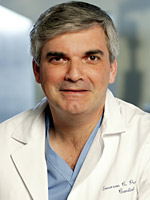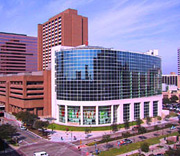Study Shows Potential for Stem Cell Therapy in Patients Suffering from Heart Failure
Novel treatment may help restore heart's ability to pump
Chicago, IL (March 24, 2012) – Doctors from the Texas Heart Institute (THI) at St. Luke's Episcopal Hospital (SLEH) presented today, at the American College of Cardiology's 61st Annual Scientific Session, the results of a multi-center clinical study that measured the possible benefits of using a patient's own bone marrow cells to repair damaged areas of the heart suffering from severe heart failure, a condition that affects millions of Americans.
The study, which was the largest such investigation to date, found that the hearts of the patients receiving bone-marrow derived stem cells showed a small but significant increase in the ability to pump oxygenated blood from the left ventricle, the heart's main pumping chamber, to the body.
The expectation is that the study will pave the way for potential new treatment options and will be important to designing and evaluating future clinical trials.
 "This is exactly the kind of information we need to move forward with the clinical use of stem cell therapy," said Emerson Perin, MD, PhD, Director of Clinical Research for Cardiovascular Medicine at THI, and one of the study's lead investigators.
"This is exactly the kind of information we need to move forward with the clinical use of stem cell therapy," said Emerson Perin, MD, PhD, Director of Clinical Research for Cardiovascular Medicine at THI, and one of the study's lead investigators.
"The bone-marrow derived stem cells are helpful to the injured heart when they are themselves biologically active," added Dr. James T. Willerson, the study's principal investigator and President and Medical Director of THI. "This study moves us one step closer to being able to help patients with severe heart failure who have no other alternatives."
The study was conducted by the Cardiovascular Cell Therapy Research Network (CCTRN), the national consortium to conduct such research funded by the National Institutes of Health's (NIH) National Heart, Lung, and Blood Institute (NHLBI).
"Studies such as these are able to be completed much faster because of the team approach of the Network," said Sonia Skarlatos, PhD, Deputy Director of the Division of Cardiovascular Sciences at the NHLBI, and Program Director of the Network.
The study involving 92 patients, was conducted at five sites, including THI, between 2009 and 2011. The patients were randomly selected to receive stem cell treatment or placebo. Their average age was 63 and they were no longer candidates for revascularization, or for surgical treatment. Each suffered from heart failure and angina (chest pain) and an ejection fraction (the percentage of blood leaving the heart's main pumping chamber, the left ventricle) of less than 45 percent.
Researchers found that left ventricular ejection fraction increased by a small but significant amount (2.7%) in patients who received stem cell therapy. The study also revealed that the improvement in ejection fraction correlated with the number of certain stem cells known as CD34+ and CD133+ in the bone marrow.
Patients' bone marrow cells were also sent to biorepository, where studies were done on the phenotypes and functional characteristics of the cells. Younger patients had a higher content of CD34+ and CD133+ cells in their bone marrow and had higher ejection fractions after stem cell treatment. This kind of analysis is essential for autologous (using a patient's own cells) therapy, said Dr. Perin. They will help identify which patients will most likely benefit from cell therapy. Such information is also important in designing future trials.
"A biorepository is a huge step forward for the future of autologous therapy because the composition and function of cells in the bone marrow may play a significant role in the outcome," added Dr. Perin. "This trial provides a sound basis for further study of the relationship between bone marrow cell characteristics and clinical endpoints."
NOTE: The CCTRN, comprising five centers, was originally funded by NHLBI in 2007. At that time, it represented the first U.S. federal funding for adult stem cell studies in which patients are treated with stem cells taken from their own bodies. In addition to THI, the original members of the CCTRN are the Cleveland Clinic, University of Florida at Gainesville, Minnesota Heart Institute and Vanderbilt University.
See also on this website: Texas Heart Institute Stem Cell Center
For media inquiries please contact:
Director of Public Affairs
Texas Heart Institute at St. Luke's Episcopal Hospital
Frank Michel ♦ 832-355-9510 ♦ fmichel@heart.thi.tmc.edu
For THI and St. Luke's media profiles, see Public Affairs.



